Torsten Neuendorff studied communication and psychology in Berlin and works as a news editor.
Torsten Neuendorff
Pictures from photographs. The work of Roger Lips
Lips's photographs were all experiments. Holding a magnifying glass over a tiny negative, he would scratch out eyes and graze faces.
Time and again he would pour aggressive chemicals onto the negatives, allowing them to penetrate the many chromogenic layers. Did Lips master the techniques he employed? Why did he alter the photograph in so many ways? Why did a firstproof-print mean so little to him? Did he cross the line between transformation and destruction? Why did he choose semi-translucent film instead of canvas? Did he manage to strike a balance between the painterly and photographic?
| Without title, 1985 | 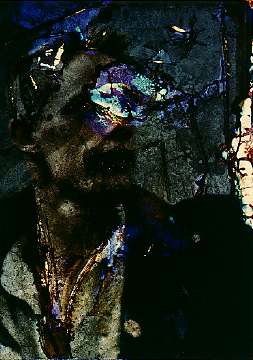 |
The outcome of an experiment is always open. In producing a picture, Lips combined various techniques of postproduction, transforming the subject of his photograph. Traditionally, photography was regarded as 'cold and detached', as an art form dependent on technical perfection: protection of the film against light, a clean lens, the appropriate distance between the photographer and his subject. Lips, however, scrutinised his pictures and constantly reworked and modified them. Through manipulation he gave his pictures the colour, shape and composition which, as he saw it, made for a good photograph. Up to his death, at the age of forty-two, he worked with an extensive archive of pictures, most already bearing traces of his experimentation. Although some seem identical, on closer inspection they can be distinguished from each other by subtle nuances in filtering. Lips stockpiled pictures for use in future series and collected photographs from newspapers as a source of fresh raw material.
 |
 |
 |
 |
 |
 |
 |
 |
 |
 |
In Lips's work the subject of a photograph - a man, a portrait, a group,
etc. - becomes 'background'. The new foreground almost defies description.
It may seem to resemble peeling paintwork or convey the impression of
shattered light. Its immense importance to Lips is reflected in his many
and meticulous processing methods. At times, he even omits the 'background'
completely, producing photographs that come close to colour abstractions.
Yet no matter how bright, how evocative his colours, they are all artificial,
the result of the interaction of chemical substances with the photographic
components. In orchestrating the colours in a single picture, Lip's role
was not unlike that of the conductor in a 'jam session'.
| Without title 1985/91 | 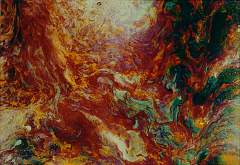 |
In the mid 1980s, he produced a work which exemplifies both his subject
choice and artistic treatment throughout his career. The upper third of
his Tryptique is a line drawing photographically reversed to a white on
black. Directly below is a colour photograph. At either side are strips
of blackened photographic paper. Dark shadows dominate, obscuring the
face of a black-haired young man, who is lit merely from behind. The darkness
in the photograph merges with the surrounding darkness. Volatile, the
sketch recalls the figurative style of the German artist, A.R. Penck,
and yet hovers on the border of abstraction.
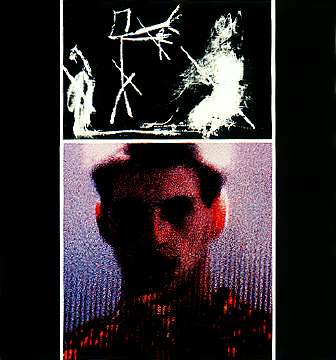 |
| Without title, 1988 |
The process of repeated reproduction created little stripes across the young man's head and softened the edges. Lips loved these techniques and applied them extensively. The apparent simplicity of Tryptique reinforces its initial impact. Although it has been interpreted both as a psychological portrait and as homage to a real-life lover, it is perhaps more rewarding to regard it from Judaeo-Christian, psychoanalytical or erotic perspective. The motif is suggestive of yearning: a face that cannot be discerned, a glow in the hair and not least the similarity to a painted altarpiece, albeit slightly out of proportion. The features evoke a sense of sympathy which outweighs the symbolism of darkness. It is relatively unimportant whether the picture is a magazine clipping, an everyday snapshot or the memento of good friend.
Lips's procedure can be compared with the 'typecasting' practised by the film industry, that is with the selection of actors for roles which they have previously played with success. For which role, then, has the young man been chosen? He remains a young, slim and beautiful man despite the technical modifications.
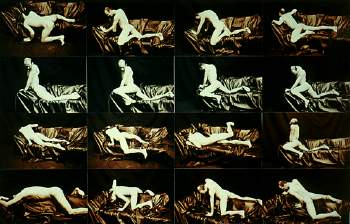 |
Without title (Rolf), 1992 |
Yet it is impossible to say whether the processing creates a beauty which, in real life, he does not possess. Hence we should not expect to find clues to his individuality or real existence in the mid-Eighties. Lips picks up what is beautiful and important and incorporates it in his picture. Like other photographers, he also used the bodies of sculptures, TV-stills or advertising photography for the same purpose. Paradoxically, a complete stranger triggers a sense of longing. Historically, Tryptique is a panel: aesthetically, it is based on the much more modern graphic techniques popularised both in poster production and advertising.
In some other pictures, Lips applies the same principles, albeit less successfully. He combined pictures to series and tableaux, yet when variation, addition or climax are half-hearted, the results are less engaging. For Lips the photographer, the artistic question of what 'worked' as a harmonious or discordant combination may have been difficult to answer. Only the viewer, perhaps, can decide. This explains the fascination of several of his diptychs of a portrait and an abstract picture.
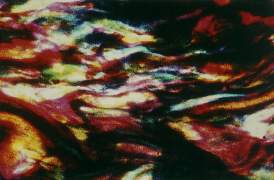 |
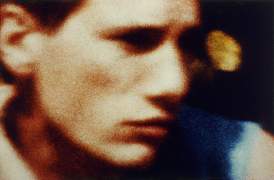 |
Without title, 1985/88 |
Without title, 1986/88 |
It has sometimes been remarked that Lips's individual works can best be interpreted in the context of his wider production. Certainly, he himself encouraged this view by careful arrangement of his pictures at each exhibition hanging. Yet given that he repeatedly shows the same faces, the comparative approach has its limitations. Indirectly, it suggests that Lips avoided the very combination that he probably desired most: a beautiful face and a perfect body and same-sex affection.
| Without title 1985/86 | 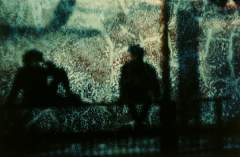 |
Lips produced his oeuvre between 1984 and 1994, an era in which Helmut Kohl led a conservative government in Germany and Ronald Reagan was re-elected US President. He often expressed dissatisfaction with his life and with the limited scope for his own artistic development. In the light of his works, this may seem surprising. Yet it highlights his preoccupation with the question of the potential of photographs as an artistic medium. Seeing photography as a means of stimulating reflection, he avoided the often vulgar or obscene images which often served to voice spontaneous protest. He did not use the debates on Aids or pornography to vent his own frustration. By contrast, the pop singer, Sinead O'Connor, tore up a picture of Pope John Paul, provoking fundamentalists to crush her CDs with a bulldozer. Photographer Robert Mapplethorpe invited the art world to share his affection for a certain type of man, with the result that America's conservatives cut state funding for critical exhibitions. By contrast, Lips preferred cautious commentary, using for example the frames of the video of the young singer, Marky Mark.
 |
 |
 |
| All without title 1992 | ||
In retrospect it seems clear that Lips understood the signs of the times: that it was now possible for a white singer to imitate black rap songs, for a youngster to sport the physical appearance of a mature muscle man, and for MTV cameras to exalt a shirtless boy with cropped hair. In presenting a tableau and a long sequence of negatives, Lips aimed to rouse the viewer to thought. Certainly, he was a gifted erotic photographer, as the tableau 'Rolf', with a naked, muscular male on black leather bed clearly illustrates. Yet by showing sixteen pictures, like a contact sheet, he avoids that erotic intensity which risked provocation.
| Without title (Frank und Karl Osswald), 1991 | 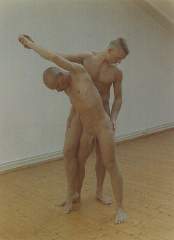 |
Even in depicting naked couples, he works like a choreographer, carefully managing the sequence of images. A shock-scene, a leather man physically attacking his lover, might have inspired Mapplethorpe, who would have seen the tension between sexual attraction and brutality. Lips had different objectives. Against the background of Aids, he adopted a critical standpoint, consciously propagating commitment and tenderness among gays.
 |
 |
|
| conserver
sex links = oben sowie als auch unten = conserver sex rechts (Artificial “canned” sex (left); above as well as below: artificial “canned” sex (right)), 1992) |
||
Lips attempted to reconcile his ideas, as expressed in the title of his show, 'Above as Beneath', with his artistic strategy. Staged scenes are casually depicted. Small pictures are presented in elaborate frames. Conventional subjects are outrageously processed.
Torsten Neuendorff, April 1999